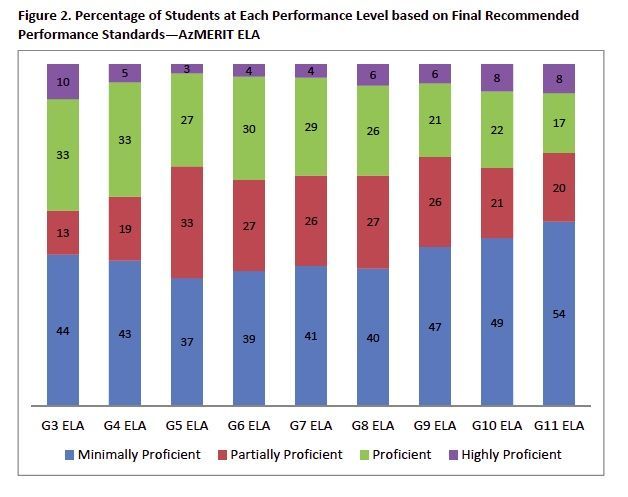About two-thirds of Arizona students failed to meet performance standards in math and English language arts on the new AzMERIT test, unofficial results show.
The preliminary results have not officially been released by the Arizona Department of Education. However, they were posted on the state Board of Education website as it prepares to adopt “cut” scores that determine whether students are proficient in the two subjects.
Should the board adopt the performance standards as the department has recommended, about 67 percent students who took the tests last spring failed to meet the mark. About 33 percent met or exceeded the standards.
Scores for individual districts and schools were not released.
The state and others predicted lower scores than normal from the AzMERIT test. They noted that the testing standards were more rigorous and that students were tested in a new format.
But for H.T. Sanchez, superintendent of Tucson’s largest school district, the results were hard to swallow.
“I don’t believe educators in Arizona are under-educating two-thirds of the state’s students in reading and math,” Tucson Unified School District’s Sanchez said. “I don’t believe that. I think our graduation rates and the number of students getting into college and the workforce is in contrast with that.”
Though Sanchez acknowledges that the new test is more rigorous, he argues that other factors should be considered when looking at the outcomes to include the appropriateness of the test and how the cut scores were reached. Further, he said that for three years, Arizona schools were gearing up for a different assessment before the state settled on AzMERIT.
Despite his concerns, Sanchez says he is hopeful that the C-rated TUSD, which traditionally has performed below the state average, will have improved.
“My hope is with all of the work we’ve done in designing a curriculum, rolling it out, training people and filling more classroom vacancies than we have in years past, that we’ll fare better than we have,” said Sanchez.
Though the data posted provide a look at performance on the state level, no district- or school-level data have been released, something that has Calvin Baker, superintendent of the A-rated Vail Unified School District, on edge.
Despite being hailed as one of the top-performing districts in the state, Baker expects that AzMERIT scores will be lower.
“We are very anxious for there to be some clarity on what is expected and what the standards are,” said Baker, who said the state results are cause for concern. “We’re starting our fourth week of the current school year and we don’t know according to the state how our students performed. So it becomes difficult to set a mark as to where we want them to go this year.”
Like Sanchez, Baker recognizes that setting goals and standards is a delicate balance. He says it’s too early to assess how well that was done for AzMERIT.
“We want to stretch kids, motivate them and give them something to reach for, but we don’t want the standards to be out of reach,” Baker said.
In arriving at the cut scores, the Arizona Department of Education enlisted more than 80 educators who made recommendations based on their grade-level expertise, working both individually and as a group.
Teachers were told to make decisions based on the labels minimally proficient, partially proficient, proficient and highly proficient to develop descriptors of what a student in each category could do.
They familiarized themselves with the line of questioning used in the tests, the response options, the correct answers and the levels of difficulty before identifying cut points. Those benchmarks were compared with other teachers, who were shown how the scores would affect students.
The teachers then went through a second round of identifying the score ranges for each category.
The state’s technical advisory council, made up of nationally recognized assessment experts, observed and reviewed the standard- setting process and found it to be “clear, well organized and logical,” saying teachers were trained to make decisions based on the content students are supposed to know rather than what category a student may fall into.
Teachers acknowledged that the standards were being set for what they want students to be able to do, not what they could do now, according to the advisory council.
The scores are said to be “generally comparable” to national measures like the National Assessment of Educational Progress (NAEP) and the ACT college readiness exam. In prior years, NAEP has found student performance to be lower than the state’s findings.
Proof of that alignment can be seen in math, where according to the state, about 42 percent of fourth-graders and 33 percent of eighth-graders were proficient. The scores for the fourth grade match NAEP exactly and the eighth-grade scores were off by just 1 percentage point.
When it came to algebra II students, the state found a lower percentage of students to be proficient — 29 percent — than ACT’s finding of 36 percent.
Though students’ performance on AzMERIT may be a shock to the Arizona school system, it is all in the name of the children, said Arizona Department of Education spokesman Charles Tack.
“We all expected to see a drop because AIMS was not measuring the same standards and it was measuring a minimum,” Tack said. “This is a much more rigorous test and it underscores how much work there is to be done. We do a disservice to students and parents when we tell them their kids meet a standard that does not accurately reflect whether they’ll be ready when they leave high school to enter the world.”
Tack added that students have been learning the standards for a short time and that teachers are still getting adjusted as well.
“When you see the lower scores, we don’t want it to be a reflection on our teachers or students, but a reflection of the system as a whole and where we can go from here.”





